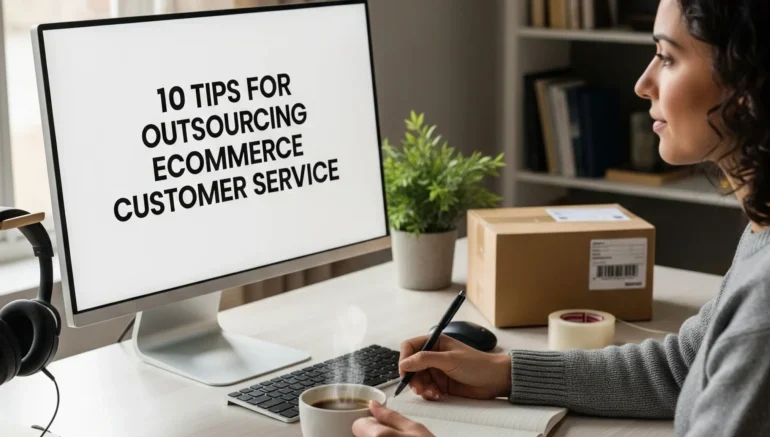
10 Tips for Outsourcing Ecommerce Customer Service
As your Ecommerce business grows, so does the need to manage customer inquiries, returns, complaints, and questions in a timely and friendly way. But hiring and training a full in house support team can be expensive and time consuming. That’s where outsourcing comes in. Working with an external customer service team allows your business to stay responsive without stretching your resources. It can save you time, money, and stress while keeping your customers happy.
However, outsourcing isn’t just about handing over tasks. It requires a thoughtful approach to make sure your brand voice, quality standards, and customer expectations are all met. A poor setup can cause confusion and lead to negative customer experiences. But a smart outsourcing plan can actually improve customer service and help your business scale faster. To guide you through the process, here are 10 clear and helpful tips for outsourcing eCommerce customer service the right way.
Here’s 10 Key Tips to Outsource eCommerce Customer Service
Know What You Want to Outsource
Before hiring a customer service provider, it’s important to clearly identify which tasks you want to outsource. Not all businesses have the same support needs. Some may only require help answering emails, while others need full service support that includes live chat, phone calls, or handling messages on social media platforms.
Start by reviewing your daily customer interactions. Which ones take up most of your time? Which tasks could be done more efficiently by someone with specialized training in customer service? Outsourcing isn’t just about saving time, it’s also about improving the overall customer experience.
 Here are Common Tasks Businesses Often Outsource:
Here are Common Tasks Businesses Often Outsource:
- Responding to product questions: Provide accurate and fast responses to customer inquiries about product features, sizes, availability, etc.
- Processing returns and refunds: Handle refund requests and returns smoothly to maintain customer trust.
- Following up on deliveries: Track packages, resolve delivery issues, and update customers proactively.
- Handling complaints: Address concerns professionally to turn a negative experience into a positive one.
- Managing support tickets: Organize and resolve issues using customer service platforms (like Zendesk or Freshdesk).
Choose a Provider with eCommerce Experience
Not all customer service teams understand how online stores work. You want to partner with someone who already knows the ins and outs of eCommerce platforms, shipping policies, payment systems, and how to speak with online shoppers.
 A team with eCommerce experience can solve problems faster and know what customers usually ask about. Look for providers who have handled support for online stores before, especially in your industry. That way, they’ll already know the type of help your customers might need.
A team with eCommerce experience can solve problems faster and know what customers usually ask about. Look for providers who have handled support for online stores before, especially in your industry. That way, they’ll already know the type of help your customers might need.
Look for a Team with Experience In:
- eCommerce platforms like Shopify or WooCommerce
- Shipping and return policies
- Payment and refund issues
Keep Your Brand Voice Consistent
Your customer service team represents your brand in every interaction, so their tone, language, and communication style should always reflect your brand identity. If you’re managing support in-house or working with an outsourced team, customers should receive the same quality of service and familiar tone they’ve come to expect.
To achieve this consistency, provide your service provider or internal team with a detailed brand voice guideline. This should clearly explain how to engage with customers in different situations.
 Consider Including the Following:
Consider Including the Following:
- Standard greetings and phrases: Provide examples of opening and closing lines that align with your brand’s personality (e.g., upbeat and casual vs. respectful and formal).
- Tone of voice: Specify if your brand voice is friendly, professional, humorous, compassionate, or a mix, and when each tone is appropriate.
- Complaint handling protocol: Outline how to acknowledge frustrations, validate the customer’s experience, and provide a calm, solution oriented response.
- Apology and resolution strategy: Explain when it’s appropriate to say sorry, how to do it sincerely, and how to offer helpful next steps without making false promises.
- Dos and Don’ts: Include a quick reference list of words, phrases, or behaviors to avoid and preferred alternatives.
Train Your Outsourced Team
Outsourcing your customer service doesn’t mean skipping the training phase. Even if you hire a highly experienced team, they still need time to understand your specific products, services, policies, and workflow. Without proper training, even skilled agents can make mistakes that impact customer satisfaction.
Investing in clear, structured on boarding helps your outsourced team respond accurately and confidently. It also builds alignment between your internal expectations and their daily interactions with customers.
 Share Clear Resources Like:
Share Clear Resources Like:
- Product manuals or feature guides: Detailed documents that explain how your offerings work, including technical specifications, key benefits, and common use cases.
- Frequently Asked Questions (FAQs): A compiled list of recurring customer concerns and appropriate answers to ensure quick and consistent support.
Use Tools That Help Track Performance
When outsourcing customer service, it’s important to monitor how well your team is performing. This ensures your customers continue to receive quality support. Use tools like helpdesk software, ticketing systems, or customer satisfaction surveys to measure response time, resolution rate, and feedback. These tools give you clear data on what’s working and what needs improvement. Regular performance reports also help you stay informed without micromanaging. With the right tools, you can maintain high service standards and quickly address any issues.
Use Tools that Let You:
- Monitor response times
- Check customer satisfaction ratings
- View support tickets and how they were handled
- Track repeat issues and feedback
Set Clear Expectations from the Start
 Avoid confusion by setting clear rules with your outsourcing partner from the very beginning. Everyone should understand what is expected, how fast replies should be, and how problems should be handled.
Avoid confusion by setting clear rules with your outsourcing partner from the very beginning. Everyone should understand what is expected, how fast replies should be, and how problems should be handled.
Some Things to Agree on Include:
- Working hours and time zones
- Response time targets (like within 24 hours)
- Which tools or software to use
- How to escalate serious issues
Stay Involved in the Process
Outsourcing ecommerce customer service doesn’t mean stepping away completely. Staying involved ensures the support team continues to meet your brand’s standards and customer expectations. Regular engagement helps catch issues early and build a stronger working relationship with your provider.
You Can Do this By:
- Holding regular check-ins or review meetings
- Requesting performance reports and KPIs
- Reviewing support calls, chats, or email transcripts
- Providing feedback and coaching when needed
Start Small Before Expanding
 If it’s your first time outsourcing ecommerce customer service, avoid handing over your entire operation right away. Starting with a limited scope, such as handling basic inquiries, live chat, or after hours support lets you test the waters without putting your full customer experience at risk. This controlled rollout helps both you and your service provider learn and adjust before scaling up.
If it’s your first time outsourcing ecommerce customer service, avoid handing over your entire operation right away. Starting with a limited scope, such as handling basic inquiries, live chat, or after hours support lets you test the waters without putting your full customer experience at risk. This controlled rollout helps both you and your service provider learn and adjust before scaling up.
Starting Small Gives You the Opportunity To:
- Evaluate team performance in real customer interactions
- Spot gaps or misunderstandings in training, tools, or processes
- Build mutual trust with the outsourced team gradually
- Gather feedback from customers and internal stakeholders
- Refine workflows and improve communication before full deployment
Choose the Right Location for Your Support Team
 Outsourcing customer service doesn’t always mean offshoring, but if you choose to work with a team in another country, the location matters. Factors like time zone, language proficiency, and cultural alignment can directly impact the quality of support your customers receive. A mismatch in any of these areas can lead to misunderstandings, delays, or a poor customer experience.
Outsourcing customer service doesn’t always mean offshoring, but if you choose to work with a team in another country, the location matters. Factors like time zone, language proficiency, and cultural alignment can directly impact the quality of support your customers receive. A mismatch in any of these areas can lead to misunderstandings, delays, or a poor customer experience.
Here are a Few Tips:
- Language clarity: Choose a team that can speak and write in your customers’ preferred language fluently and naturally.
- Time zone compatibility: Make sure their working hours align with your peak customer activity or business hours.
- Cultural fit: Select a team that understands your customers’ communication style and expectations, especially when resolving complaints or complex issues.
Keep Your Customer Data Safe
 Customer data is sensitive, and protecting it should always be a top priority, especially when outsourcing your support. Sharing information with a third party provider increases the risk of data breaches if proper safeguards aren’t in place. That’s why it’s important to work with a team that takes privacy and security seriously.
Customer data is sensitive, and protecting it should always be a top priority, especially when outsourcing your support. Sharing information with a third party provider increases the risk of data breaches if proper safeguards aren’t in place. That’s why it’s important to work with a team that takes privacy and security seriously.
Ask them About:
- How they store and manage customer data
- Who has access to customer details
- What steps they take to prevent data leaks
- If they follow rules like GDPR or other data laws in your area
Conclusion
Outsourcing eCommerce customer service can be a smart and cost effective way to grow your business while keeping your customers satisfied. But success doesn’t come from simply handing off task, it requires careful planning, clear communication, and consistent involvement. By starting small, training your team well, and using the right tools to track performance, you can maintain quality service without losing control. It’s also important to choose a provider who understands your industry and can represent your brand just like an in-house team would. Don’t forget to stay involved through regular check-ins, feedback, and performance reviews. Protecting customer data and ensuring alignment in tone, time zone, and culture are also key to building trust.
Read Next: 10 Proven Startup Marketing Strategies










